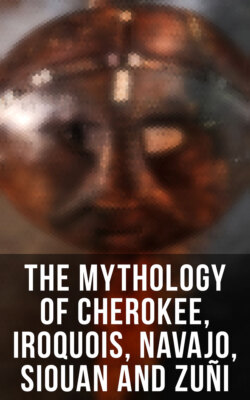Читать книгу The Mythology of Cherokee, Iroquois, Navajo, Siouan and Zuñi - James Mooney - Страница 6
На сайте Литреса книга снята с продажи.
Preface
ОглавлениеTable of Contents
The North American Indian has so long been an object of the deepest interest that the neglect of his picturesque and original mythologies and the tales to which they have given rise is difficult of comprehension. In boyhood we are wont to regard him as an instrument specially designed for the execution of tumultuous incident, wherewith heart-stirring fiction may be manufactured. In manhood we are too apt to consider him as only fit to be put aside with the matter of Faery and such evanescent stuff and relegated to the limbo of imagination. Satiated with his constant recurrence in the tales of our youth, we are perhaps but too ready to hearken credulously to accounts which picture him as a disreputable vagabond, getting a precarious living by petty theft or the manufacture of bead ornaments.
It is, indeed, surprising how vague a picture the North American Indian presents to the minds of most people in Europe when all that recent anthropological research has done on the subject is taken into account. As a matter of fact, few books have been published in England which furnish more than the scantiest details concerning the Red Race, and these are in general scarce, and, when obtained, of doubtful scientific value.
The primary object of this volume is to furnish the reader with a general view of the mythologies of the Red Man of North America, accompanied by such historical and ethnological information as will assist him in gauging the real conditions under which this most interesting section of humanity existed. The basic difference between the Indian and European mental outlook is insisted upon, because it is felt that no proper comprehension of American Indian myth or conditions of life can be attained when such a distinction is not recognized and allowed for. The difference between the view-point, mundane and spiritual, of the Red Man and that of the European is as vast as that which separates the conceptions and philosophies of the East and West. Nevertheless we shall find in the North American mythologies much that enters into the composition of the immortal tales of the older religions of the Eastern Hemisphere. All myth, Asiatic, European, or American, springs from similar natural conceptions, and if we discover in American mythology peculiarities which we do not observe in the systems of Greece, Rome, or Egypt, we may be certain that these arise from circumstances of environment and racial habit as modified by climate and kindred conditions alone.
In the last thirty years much has been accomplished in placing the study of the American aborigines on a sounder basis. The older school of ethnologists were for the most part obsessed with the wildest ideas concerning the origin of the Indians, and many of them believed the Red Man to be the degenerate descendant of the lost Ten Tribes of Israel or of early Phoenician adventurers. But these 'antiquaries' had perforce to give way to a new school of students well equipped with scientific knowledge, whose labours, under the admirable direction of the United States Bureau of Ethnology, have borne rich fruit. Many treatises of the utmost value on the ethnology, mythology, and tribal customs of the North American Indians have been issued by this conscientious and enterprising State department. These are written by men who possess first-hand knowledge of Indian life and languages, many of whom have faced great privations and hardships in order to collect the material they have published. The series is, indeed, a monument to that nobler type of heroism which science can kindle in the breast of the student, and the direct, unembellished verbiage of these volumes conceals many a life-story which for quiet, unassuming bravery and contempt for danger will match anything in the records of research and human endurance.
LEWIS SPENCE
EDINBURGH: March 1914
